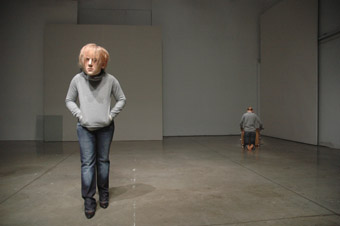 |
Hey Girl!, Socìetas Raffaelo Sanzio Raffaelli |
For better or worse, the connection to Princess Diana is made in and I can’t shake it. I find myself wondering how Romeo Castellucci felt on hearing the news of Diana’s death? Was he distressed? Did he rage against the paparazzi, those dreadful men who hunted down and killed this “beautiful woman”? At one point in the show, Everygirl kneels next to the sword and lists the women – Anne Boleyn, Marie Antoinette, Katherine II of Russia – who “lost their heads on account of the people”. I don’t think Diana made the list but it is certainly company she would feel at home in. My sense is that – at core – Everygirl doesn’t represent all women but rather those beautiful women objectified by men only to be destroyed by them. It has to be noted that Everygirl is stunningly beautiful. She’s also fit. And blonde.
Rather revealingly, the central performer’s name is missing from the PuSh program guide [and there is no print program at the venue]. I don’t know whether this is an administrative error but would not be surprised if it was a conscious choice. Objectification is a central theme of the work. In an early scene, Everygirl moves slowly to the back of the stage and stands on a pedestal. She’s naked but her features are blurred through the haze of smoke that clouds the theatre. She reminded me very much of those small, wooden dolls that artists use to strike different poses – she is strangely inhuman. She then moves downstage and beats a drum with violent force and emotion as if – perhaps – to signify both her emotional energy and individuality. She dresses in jeans and a white t-shirt. I liked this touch as it made the performer both human and very contemporary in what is an extremely abstract environment. We could recognize her, although not so much as the girl next door as Kate Moss dossing around the house on a Sunday afternoon.
In the necessary short-hand our society is addicted to, Romeo Castellucci is described as Europe’s answer to Robert Lepage, the theatre auteur from Quebec. In the usual way of these things, it’s a misleading description. Lepage is an inherent performer and storyteller; both roles are woven into the very fibre of his work. Castellucci, on the other hand, is a designer who borrows heavily from the visual arts field. Lepage uses innovate design and stagecraft, these tend to be pure and simplified and used to support both narrative and theme. Lepage uses simplicity to convey complexity. Castellucci – at least with Hey Girl – uses visual and auditory complexity to reveal…not much, really.
That said, Hey Girl is one of the most visually stunning and technically brilliant shows I’ve ever seen. It is also one of the most didactic and condescending. I longed for depth but I fear there is none. When Everygirl points accusingly at the audience, I think it’s sincere. But I wonder if the brutal treatment of women in Western culture was news to many members of the audience? There is also a rather disturbing psychology underlying this work which links back to the notion of objectification. There is a scene where approximately 30 men invade the stage. The smoke in the theatre casts them in shadow and – while three of their brethren watch through a glass window – they beat the woman with what look like pillows or sacks. The image is heavily stylized but still distressing. After the beating the men line up and in flashes of light we are able to make out their features. They are us! Men drawn from the street! I couldn’t help but reminded of certain Hollywood films which show women being beaten and raped because we need to know just how brutal men can be. It wasn’t nearly that extreme but I do wonder at reproducing the pathology that objectifies a woman and then beats her. I realise this is the point but I don’t feel Castellucci earned this moment nor do I believe that the thin thematic content justified it. The simple code of the piece is: beautiful girl is alone, confused and abandoned, an object of desire she’s beaten by men only to rise again ready to kick ass, Buffy-like sword at the ready.
But wait there’s more! There’s a scene where L and R appear on opposing sides of the stage. These large letters light up – with a deafening racket – while Everygirl races between them as if pulled to and fro! Later, Slavegirl (a gorgeous, of course, black woman) appears and Everygirl buys her from a slave trader! Everygirl pleads “what must I say, what must I do”! This is a world where women are not capable of being agents of change. It is a world where women are isolated and victimized (until they discover sisterhood, as defined by Castellucci). This is the thin gruel we are left to digest.
But why would I encourage you to see it? Because it is visually (and to a lesser extent aurally) stunning: in particular, the opening sequence where Everygirl is lying on what looks like a coroner’s table, covered in dripping latex paint which has formed a skin over her body. It is beautiful, haunting and unforgettable. There’s a clip from this scene on the internet. See for yourself how beautiful the performer is. Maybe you can even discover her name.
Socìetas Raffaelo Sanzio, Hey Girl!, director, design, lights, costumes Romeo Castellucci, performers Silvia Costa, Sonia Beltran Napoles, original music Scott Gibbons, statics and dynamics Stephan Duve, lighting technique Giacomo Gorini, Luciano Trebbi, sculptures Plastikart, Istvan Zimmerman; Frederic Wood Theatre, University of British Columbia, Jan 23-26; PuSh International Festival of Performing Arts, Jan 16-Feb 3
Andrew Templeton is Vancouver-based writer and playwright who's had plays produced in Vancouver and London.
© Andrew Templeton; for permission to reproduce apply to [email protected]








 back
back